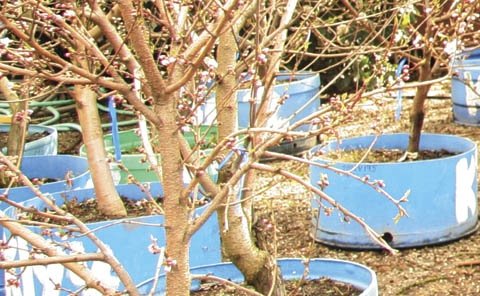
Pollinating season each year at Zaiger Genetics, Inc., is a time of hope and promise. It’s when thousands of crosses are made in the search for new stone fruit varieties, rootstocks, and interspecifics.
While visiting Zaiger Genetics in Modesto, California, members of the International Fruit Tree Association watched seasoned fingers emasculate the blossoms from potted trees and swab a dab of pollen on each pistil. The crew of women, some of whom have been pollinating at Zaiger’s for more than 40 years, have 2,000 trees of mother stock in barrels to work during the season, using pollen from 450 different selections. They have a short time frame to pollinate the blossoms, as the pistils are viable only for about 24 to 36 hours once the blossoms are removed.
Floyd Zaiger started the privately owned breeding company 50 years ago, initially breeding heat-tolerant azaleas and rhododendrons. His interest in stone fruit breeding was sparked after he worked with Fred Anderson, often referred to as the father of the modern-day nectarine. Zaiger’s first famous release was the Royal Gold peach. Today, Floyd’s daughter Leith Zaiger Gardner has taken over many of the company duties.
Trees on which the crosses are made are now grown in barrels so they can be moved in and out of a greenhouse during pollination. About 400 trees are discarded every year, with 400 added, explained Gardner. They also grow about 60,000 seedlings every year.
“If we think the seedling has potential, we’ll bud it on an older rootstock, so we can see fruit in the second year,” said Gardner. “Otherwise, it is three years before we can evaluate any fruit.”
Another common practice they use is to put eight bud sticks of different seedlings on one Nemaguard rootstock to evaluate different crosses under the same parameters. The trees are not pruned or thinned, and are budded in the same year that the crosses were made (crosses are made in the spring and budded in the fall).
Broad focus
Zaiger’s has a broad focus in its breeding program, trying to develop flavorful and unique apricots, prunes, plums, cherries, peaches, and nectarines, low-chilling stone fruit varieties, fireblight-resistant Asian pears, and self-fertile almond varieties. They have released two cherry varieties, Mini Royal and Royal Lee, that require zero chilling hours.
Additionally, they have heightened their focus on breeding interspecifics—crosses of different species, like the plum and apricot that resulted in the Zaiger trademarked Pluot and Aprium.
They also are working on saucer- or peento-shaped Pluots that are similar in shape to the donut peaches, a wide variety of apricot and plum hybrids that include peach genetics, interspecific nectarines that are crossed with plums (some having white flesh and spicy flavors), and interspecific peaches that have been crossed with apricots and plums.
In the area of rootstocks, which take about 20 years for development before commercial release, they are looking for rootstocks that are size controlling, easy to grow, and are resistant to crown gall. Some of their rootstock work involves breeding hybrid or interspecific rootstocks (such as plum and peach, almond and plum, and apricot and peach) and interstems. Examples of recently released hybrid rootstocks are Atlas, Citation, Viking, and the Zee Stem.
The Zee Stem is being used by California cherry growers to eliminate rootstock compatibility issues, increase precocity, and decrease tree size.

Leave A Comment